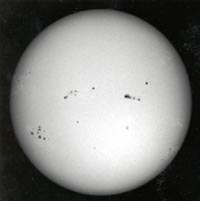MUNICIPALITY OF LARISSA Observatory of Larissa
SUN
1)Photosphere
We take impressions of the photosphere phenomena daily on 20cm paper. After relevant elaboration and estimation, the observations are then sent to three international astronomical centers, the Solar Part of the American Association ofVariable Stars (AAVSO), the Observatoire Royal de Belgique and the British Astronomical Association in England and the Volssternwarte Paderborn in Germany. Also, we photograph the photosphere daily by digital camera Canon EOS 5D.
2)Chromosphere
The Observatory of Larissa participates in the important international research program High Energy Solar Spectroscopic Imager (HESSI). This program concerns the simultaneous observation from the satellite HESSI and earth observatories of specially selected active areas of the Sun's chromosphere where flares may be developed. The aim of the program is that the combined observations contribute to the understanding the solar flares generation mechanism and the natural causes which create them as well as the release of vast energy quantities throughout the whole electromagnetic spectrum. To photograph those active areas we use the monochromatic filter Lyot, at the line Ha of the hydrogen (6563 A ), capable of carrying the light from the center of the line Ha, from ± 0.1 A up to 1.0 A , towards the red and blue part of the spectrum and thus, it is possible to study the activity of the gasses. Also, with the special digital camera PRO LINE PL 11002M-2 by Finger Lakes Instrumentation, attached to the filter Ha and portable computer, we receive the photographs with rate one per minute.
Hours of H-alpha Flare Patrol of RHESSI targets
3)Sudden Ionospheric Disturbance (SID)
The program SID concerns the indirect electronic monitoring of the solar flares. Its basic principle is as follows: There is a continuous monitoring of the signal (carrier) which is transmitted by an earthy station at VLF (very low frequencies) using the ionosphere as a means of relay. During a solar flare, the intense electromagnetic radiation released causes ionospoheric disturbances resulting to the monitoring of an intense disturbance with amplification or debilitation of the signal (which is monitored by the electronic receiver of the Observatory). After the relevant calculations and valuations of the data at the end of each month, the monthly bulletin of the Observatory of Larissa " ObsLar Bulletin " which includes the corresponding flares characteristics (Start, Max, End, Importance) is sent to the A.A.V.S.O. in the USA, the Observatoire Royal de Belgique, the British Astronomical Association and the Volssternwarte Paderborn in Germany. The international code of the Observatory of Larissa for this program is Á107.
OBSLAR Bulletin (SID report )
